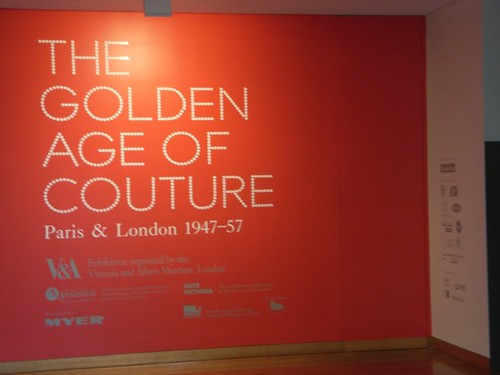We weren't the only tourists who were drawn to Bendigo by this exhibition - not only an extraordinary exhibition, but also the only place to see it in Australia.
It's in a separate wing/entrance of the gallery, and with an admission charge ($16 for adults). Clever window decals, too (note the artwork/sculpture pretend pavilion in the background).
Allow yourself plenty of time. Last entry is 4.15pm, but you'd want well more than 45 minutes: if you watch the films of couture being made and shown, they run for well over half an hour on their own.
But of course what you want to see are the frocks and gowns, hats and suits and the elegance and style of it. The exhibition was first shown at the Victoria and Albert museum in London, which has a legendary collection of costume, fashion, couture and design. They called it "The Golden Age of Couture: Paris and London 1947 - 1957" and their website is more generous with images at this link .
If you're interested in the exhibition catalogue, this is what it looks like:
(That dress is beautiful!). The catalogue is a published book ie. available from booksellers, not just the galleries. The Book Depository (free shipping worldwide) has it here (from whence I borrowed the image). It was about $60AU at the gallery.
.
There's a public carpark at the back of the gallery that has sections for up to four hours of parking. Rates are cheap: we approved of the Bendigo habit of charging for parking, but not a lot - so people do move on and parking spaces are available.
.
And after all that practical information, what will you see?
.
Beautiful beautiful clothes, made with skills you can hardly imagine - thousands and thousands of hand-sewn beads on a single bodice, the cutting and draping of fabric to create quiet elegance. A whole way of living, walking, standing, being that's utterly different to how most of the world lives or will ever live, even in our well-off first world society.
.
It also struck me how so many of these clothes were not made for broomstick figured young women, as is the focus of so much 'high fashion' today. Women of many ages could wear these and have elegance and style. Some were made for the wives of rich men, but some also for women with husbands in high positions, ambassadors or representatives, who needed a 'working wardrobe' of this sort of style, like the women of the royal family (at which point I'll note that Princess Margaret was apparently an early adopter of Dior's New Look and judging by the garments on display, she had a tiny tiny waist).
.
Part of the exhibition included dressed dolls: there were at least two touring exhibitions put together just after the war, with (skeletal wire with papier mache faces and real hair) doll figures dressed by couturiers in Paris and London to show these new fashions (and in a way that was less expensive than making full size costumes). There were also photographs of the clothes by people such as Richard Avedon, with excellent information on how these were composed to highlight the clothes, and how the style of photography was changing to a more active style, rather than stiffly posed models.
.
The lighting is low, as you would expect with fragile textiles. In just one case, the shadows cast by the placement of lighting meant you couldn't see something well enough, but the rest was fine.
.
Lovely, lovely work to see. Don't miss it. It closes late in March 2009.
.











1 comment:
I just got back from seeing the exhibition and think that Bendigo is pretty lucky place to have the exhibition. The clothes were just gorgeous werent they!
I am happy that you liked visiting Bendigo!
Post a Comment